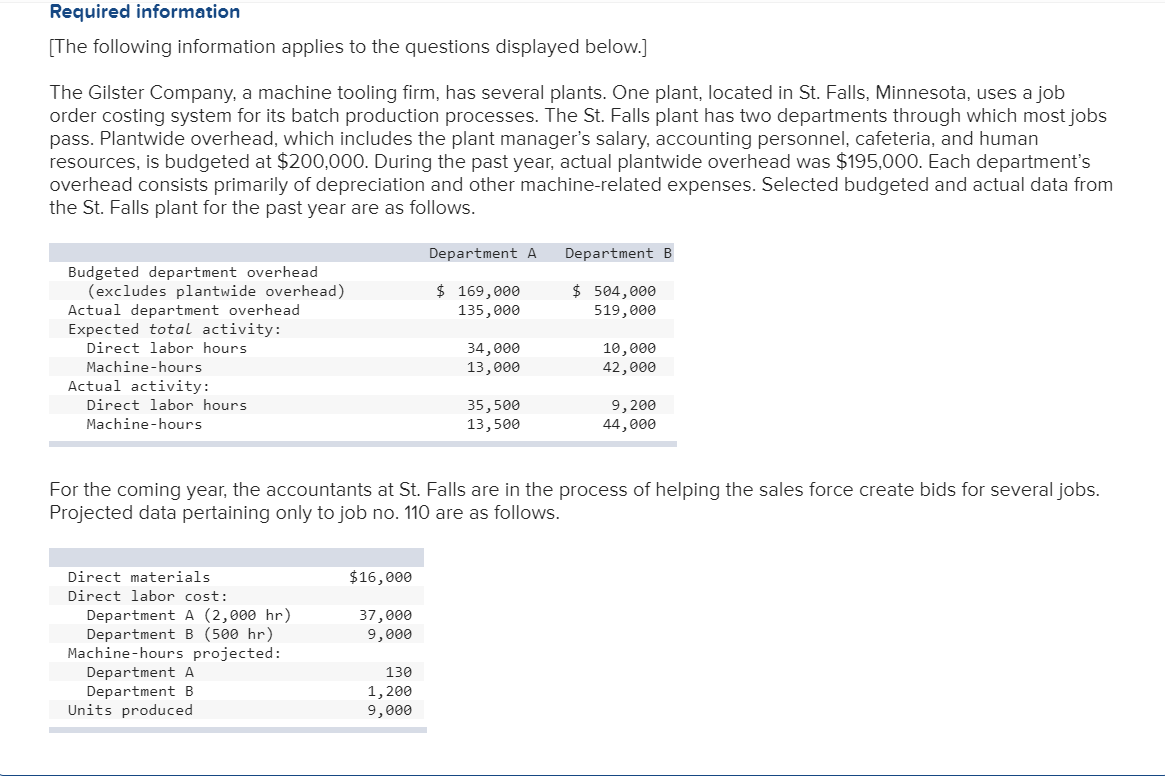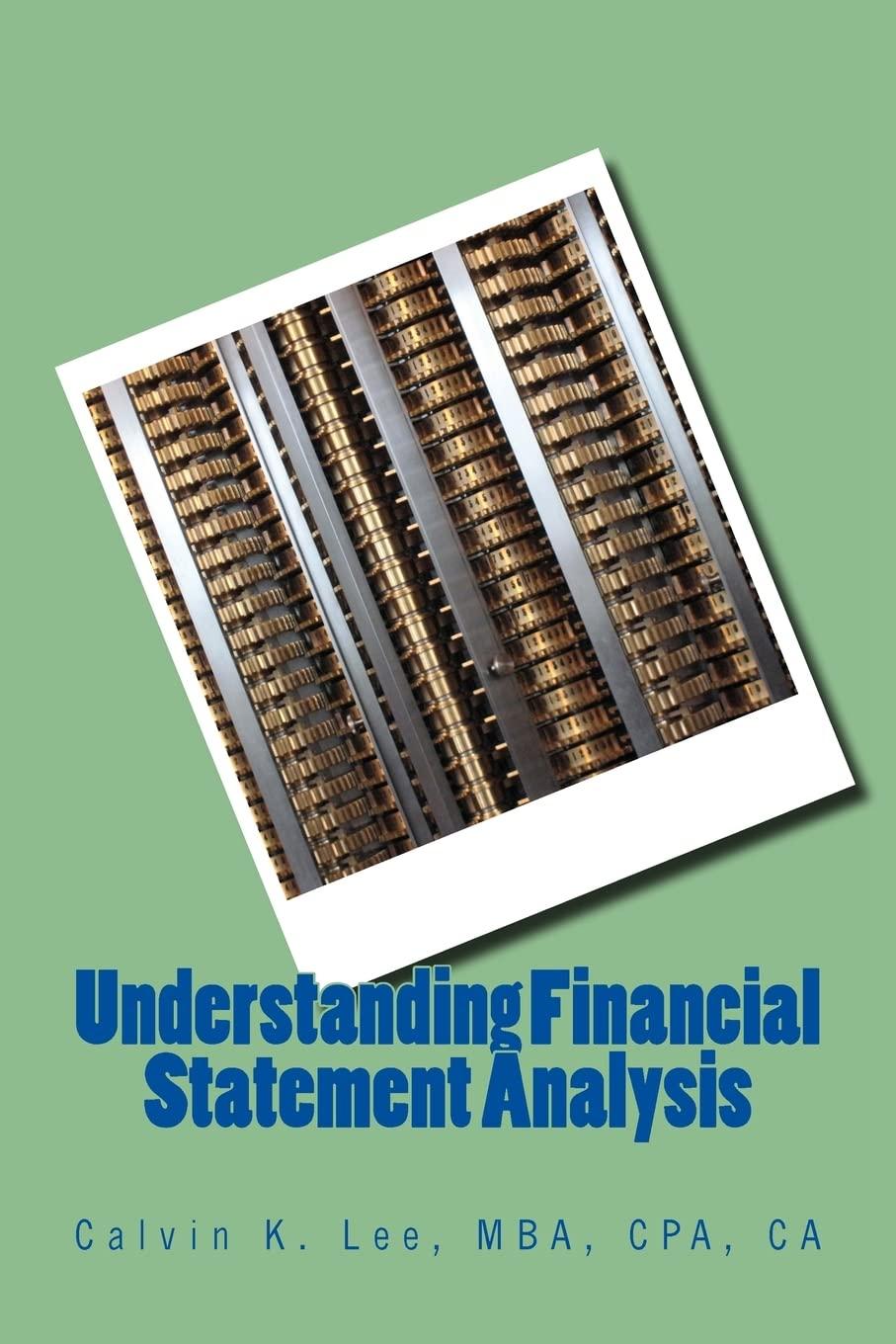







 I need help with the C part, please.
I need help with the C part, please.
Required information [The following information applies to the questions displayed below.) The Gilster Company, a machine tooling firm, has several plants. One plant, located in St. Falls, Minnesota, uses a job order costing system for its batch production processes. The St. Falls plant has two departments through which most jobs pass. Plantwide overhead, which includes the plant manager's salary, accounting personnel, cafeteria, and human resources, is budgeted at $200,000. During the past year, actual plantwide overhead was $195,000. Each department's overhead consists primarily of depreciation and other machine-related expenses. Selected budgeted and actual data from the St. Falls plant for the past year are as follows. Department Department B $ 169,000 135,000 $ 504,000 519,000 Budgeted department overhead (excludes plantwide overhead) Actual department overhead Expected total activity: Direct labor hours Machine-hours Actual activity: Direct labor hours Machine-hours 34,000 13,000 10,000 42,000 35,500 13,500 9,200 44,000 For the coming year, the accountants at St. Falls are in the process of helping the sales force create bids for several jobs. Projected data pertaining only to job no. 110 are as follows. $16,000 37,000 9,000 Direct materials Direct labor cost: Department A (2,000 hr) Department B (500 hr) Machine-hours projected: Department A Department B Units produced 130 1,200 9,000 Required: a-1. Assume the St. Falls plant uses a single plantwide overhead rate to assign all overhead (plantwide and department) costs to jobs. Find the overhead rate by using expected direct labor hours. a-2. Determine the projected amount of total manufacturing costs per unit for the units in job no. 110. Complete this question by entering your answers in the tabs below. Req A1 Req A2 Assume the St. Falls plant uses a single plantwide overhead rate to assign all overhead (plantwide and department) costs to jobs. Find the overhead rate by using expected direct labor hours. (Round your answer to 2 decimal places.) Overhead rate $ 19.84 per direct labor Complete this question by entering your answers in the tabs below. Req A1 Req A2 Determine the projected amount of total manufacturing costs per unit for the units in job no. 110. (Round your intermediate calculations and final answer to 2 decimal places.) Manufacturing costs for Job 110 $ 12.40 12.40 per unit Assume the St. Falls plant uses three separate overhead rates to assign overhead costs to jobs. b-1. Find the plant wide overhead rate by using expected machine hours. b-2. Find the department overhead rate using expected machine hours for Department A and Department B. b-2. Calculate the projected manufacturing costs for job 110 using the three separate rates computed in b-1 and b-2. Complete this question by entering your answers in the tabs below. Reg B1 Req B2 Req B3 Find the plant wide overhead rate by using expected machine hours. (Round your answer to 2 decimal places.) Plantwide overhead rate per machine $ 3.04 hour Complete this question by entering your answers in the tabs below. Req B1 Req B2 Req B3 Find the department overhead rate using expected machine hours for Department A and Department B. (Round your answer to 2 decimal places.) $ 13.00 per machine hour Overhead rate- Department A Overhead rate- Department B $ 12.00 per machine hour Complete this question by entering your answers in the tabs below. Req B1 Req B2 Req B3 Calculate the projected manufacturing costs for job 110 using the three separate rates computed in b-1 and 5-2. (Round your intermediate calculations and final answer to 2 decimal places.) Total cost s 9.21 Dent c-1. The sales policy at St. Falls dictates that job bids be calculated by adding 22 percent to total manufacturing costs. What would be the bid for job no. 110 using the overhead rate from part a? c-2. The sales policy at St. Falls dictates that job bids be calculated by adding 22 percent to total manufacturing costs. What would be the bid for job no. 110 using the overhead rate from part b? c-3. Which of the overhead allocation methods would you recommend? Complete this question by entering your answers in the tabs below. Req C1 Req C2 Req C3 The sales policy at St. Falls dictates that job bids be calculated by adding 22 percent to total manufacturing costs. What would be the bid for job no. 110 using the overhead rate from part a? (Round your intermediate calculations to 2 decimal places and final answer to the nearest whole dollar amount.) Bid price $ 15 Complete this question by entering your answers in the tabs below. Req C1 Req c2 Req C3 The sales policy at St. Falls dictates that job bids be calculated by adding 22 percent to total manufacturing costs. What would be the bid for job no. 110 using the overhead rate from part b? (Round your intermediate calculations to 2 decimal places and final answer to the nearest whole dollar amount.) Bid 11 X price Complete this question by entering your answers in the tabs below. Req C1 Reg C2 Reg C3 Which of the overhead allocation methods would you recommend? Which method would you recommend? Overhead rate by machine hours








 I need help with the C part, please.
I need help with the C part, please. 





